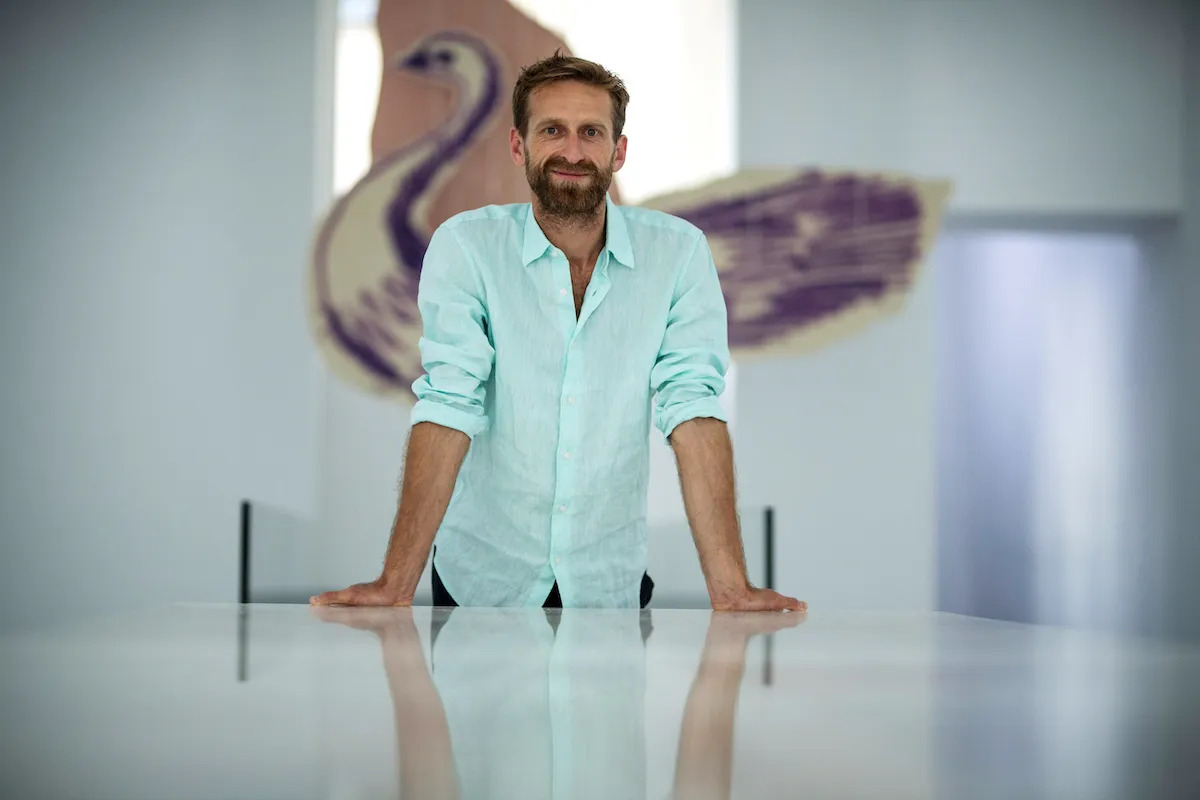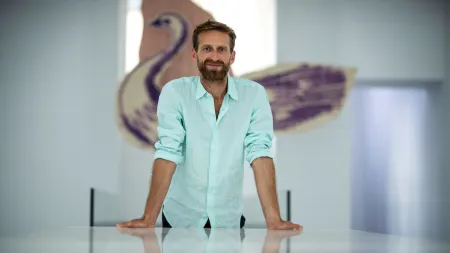
If you are lucky enough to board specific Aeroméxico flights right now, you might find yourself greeted by a plane that is host to an artwork. The painting, which appears on the aircraft’s side, depicts a flying chicken that appears to soar when the plane takes off. “From Runik with love,” reads text in Albanian that is scrawled on the fuselage.
The painter of this chicken is Petrit Halilaj, the young Kosovar artist who remains a sensation, with grand installations of his appearing in biennials and museums across Europe. Halilaj has never been one to color within the lines dictated by institutions—he once diverted funds from the Berlin Biennale to build a new house for his family—and so it only makes sense that his first show in Latin America exists not only within museum walls but also in the form of an airplane that traverses the globe.
Right now, you can ride that Aeroméxico plane to Mexico City, where, at the Museo Tamayo, Halilaj is mounting something akin to a mid-career survey. It features an array of artworks that attest to his various modes: gigantic sculpted flowers, avian avatars, larger-than-life chicken legs. All are set within the Museo Tamayo’s iconic atrium, which, like Halilaj’s art, renders the boundary between natural and industrial fuzzy.
All the art that Halilaj produces has a fantastical vibe, as though it could not possibly be set in our universe. But when Halilaj spoke by Zoom this week from his Berlin apartment, it became apparent that his art is simply a mirror of his own world. His walls were lined with green plants, and he spoke of the joy of hosting 12 uncaged canaries indoors during lockdown.
“I truly believe in blurring what is life and what is work,” he said with a smile. “You know, some of my projects have made my life better.”
To learn more about the exhibition at the Museo Tamayo, which is hosting its annual gala tonight, ARTnews spoke with Halilaj, who is also currently readying a rooftop commission for the Metropolitan Museum of Art in New York.
This interview has been edited and condensed for clarity.
ARTnews: The architecture of the Museo Tamayo, which is set in Mexico City’s Chapultepec Park, has such a rich history. How much did you consider it when you were doing this exhibition?
Petrit Halilaj: I really needed to know the space. I needed to know the intention of [artist Rufino Tamayo, the museum’s founder], how the museum had its own identity, how it connected Mexico with international voices. Knowing the space, the animals, the dogs in the park, the birds—it was all very important. There’s this incredible relation between inside and outside, natural and manmade that’s being blurred.
I was super thrilled when the director of museum [Magalí Arriola] told me that someone puts flowers every week in the courtyard. She hasn’t seen who puts these flowers there because it happens on the weekend. I thought: Wow! And I didn’t want to know, either. Maybe it’s one of the guards or the people who works in storage.

You’ve frequently meditated on what constitutes a home, and indeed, the Tamayo show even includes a sculpture intended to replicate the structure of your family’s home in Kosovo.
José [Esparza Chong Cuy, the show’s curator] and I started to talk about the difference between a house and a home. That’s probably where my difficulty to enter Mexico comes in. I couldn’t even apply for a visa because Mexico has no diplomatic relation with Kosovo.
I couldn’t go to Mexico for many years—I only could go once I had an Italian passport through Álvaro [Urbano, the artist to whom Halilaj is married]. When I finally got the passport, we decided to do our honeymoon in Mexico. Magali toured us around the space and invited me to do the show. I was already imagining live chickens and everything. She was like, “Do you like the space?” And I was like, “I love it.” My first temptation was to have chickens and other animals in around the museum, and to open the garden up. But because of the collection, this was not possible.

The show is titled “RUNIK,” after a Neolithic settlement in Kosovo, which has been something you’ve repeatedly addressed in your art. Most Mexican audiences will likely have no relation to the history of Runik, however. Do you mind that?
The title of the exhibition refers to a precise place in time and space and geography that is so far that it can become this imaginary land. Ninety-nine percent of [viewers] have never heard of it. Also, Mexico, like many other countries in the world, doesn’t recognize Kosovo. I knew that Albanian speakers from Kosovo would not come to the show because they cannot enter.
How did the Aeroméxico commission come about?
Since the beginning, I wanted to do something that was not in the museum. I was happy that I was able to integrate Pierre Huyghe’s live blind cave fishes [part of a permanent work at the museum]—normally, artists would close it during their shows.
But I was talking to José and I said, “I can’t believe that no one can fly from Kosovo to come to my show. Maybe you should just send an Aeroméxico flight to Kosovo once, then make it come back.” It was a bit of a joke, partly utopian. He was like, “Oh, maybe I can do something about that. Aeroméxico is quite supportive of the Museo Tamayo.” I come from Eastern Europe, and in the Balkans, very logical things are impossible, but very big dreams can become real. So, I understood that logic. The conversation became a meeting. That meeting became another conversation, and people from Aeroméxico grabbed it.
I used the same technique as the drawings I made in a refugee camp [as a child]. I remember chickens as my friends. I wanted to question what it means that people in a plane could fly with an artwork, or as part of a chicken, but also, I wanted to ask questions related to immigration and who can fly and who can cross borders. I love the idea that her wing kind of disappearing into the aircraft wing and that the writing is in Albanian.

It’s clear that birds recur as symbol for you, as they have for over a decade in your art. Do you feel that their meaning has changed for you over the years?
It has changed a lot. I wanted to play with this idea of home as a place of protection, but also as a place of imagination. All my feelings about birds are all together in this exhibition.
For the opening in November, you wore a bird costume, something you’ve done several times before. What was the response to that?
That costume is really relevant to me with everything going on. I felt way more comfortable as a bird than as a human being. There’s been a big shock. We have to learn how to reformulate public space and geopolitical relations. It’s an ever-shifting thing, and the bird really saved me.
So, I went to the performers in the exhibition by Ragnar [Kjartansson], which was in the other room, at different times during the opening day. The musicians came toward me, and I was like, “Guys, should we make the rounds?” We went together into the main space, where the bird lives, and it was this magical moment where the two shows totally blurred. I love that you hear Ragnar’s music throughout the whole experience. This merging of performers, I was so happy that this happened. Many of the works are custom, so I started to talk with [artist] Minerva Cuevas, and she told me about a performance she did when Denmark had very weird immigration laws. It was about an ugly duck—she has a costume. I’m working with her, Damián Ortega, and Bárbara Sánchez-Kane, and I’m in contact with Mexican artists. I want to host other artist tours in costume.
Porfirio Gutiérrez Brings His Reinterpreted Traditional Weaving Techniques Home
Mexico City’s Material Fair, Known for Its Line-Up of Cutting Edge Galleries, Celebrates 10 Years

Four Seasons Brings Sustainable Luxury to the Dominican Republic

Khloe Kardashian Embraces Biker Trends in Balenciaga and Kim Kardashian Channels Cowboy Core Fashion at Fanatics Super Bowl Party 2024

Apple just gave us a big hint that AI is taking over more than just the iPhone

A Legal Scouting Report for What’s Next in Dartmouth Basketball


